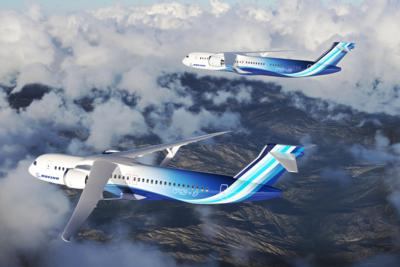Green to the Tune of $1.15-Billion
Culminating, perhaps, its hunt for a private sector partner willing to ante up monies and manpower to help design, build, test, and fly a large-scale, sustainable technology demonstrator aircraft, NASA announced on Wednesday, 18 January 2023 that it had issued an award to Boeing under the auspices of the agency’s Sustainable Flight Demonstrator project.

Per the agreement, Boeing will team with NASA to develop an aircraft featuring technologies commensurate with the near-future manufacture and fielding of a sustainable airliner.
Over a seven year period, NASA will invest $425-million and contribute technical expertise and facilities to the undertaking, while Boeing and its industry partners will provide the remainder of the agreed upon funding—estimated at $725-million.
NASA Administrator Bill Nelson somewhat hyperbolically stated: “Since the beginning, NASA has been with you when you fly. NASA has dared to go farther, faster, higher. And in doing so, NASA has made aviation more sustainable and dependable. It is in our DNA.” Mr. Nelson continued: “It’s our goal that NASA’s partnership with Boeing to produce and test a full-scale demonstrator will help lead to future commercial airliners that are more fuel efficient, with benefits to the environment, the commercial aviation industry, and to passengers worldwide. If we are successful, we may see these technologies in planes that the public takes to the skies in the 2030s.”

Single-aisle aircraft—upon which airlines predicate the overwhelming majority of their short and medium-haul routes—account for nearly half of worldwide aviation emissions. Ergo, NASA plans to complete testing of a sustainable single-aisle airliner prototype by the late 2020s. Architectures and technologies deriving of such an aircraft will inform aerospace industry decisions pertaining to future generations of narrow-body aircraft.
The demonstrator aircraft envisioned by Boeing and its industry partners comprises a high-aspect-ratio, transonic, truss-braced wing. The design’s low coefficient of drag is eminently conducive to NASA’s goals as it reduces both fuel-burn and engine emissions.
NASA associate administrator for the aeronautics research mission directorate Bob Pearce set forth: “The transonic truss-braced wing is the kind of transformative concept and investment we will need to meet those [sustainability] challenges and, critically, the technologies demonstrated in this project have a clear and viable path to informing the next generation of single-aisle aircraft, benefiting everyone that uses the air transportation system.” Mr. Pierce added: “NASA’s goal is that the technology flown on the demonstrator aircraft, when combined with other advancements in propulsion systems, materials, and systems architecture, would result in fuel consumption and emissions reductions of up to thirty-percent relative to today’s most efficient single-aisle aircraft, depending on the mission.”

To the subject of his company’s carbon-reducing efforts, Boeing chief technology officer Todd Citron stated: “We’re honored to continue our partnership with NASA and to demonstrate technology that significantly improves aerodynamic efficiency resulting in substantially lower fuel burn and emissions. Boeing has been advancing a multipronged sustainability strategy, including fleet renewal, operational efficiency, renewable energy, and advanced technologies to support the U.S. Aviation Climate Action Plan and meet the industry objective of net zero carbon emissions by 2050. The Sustainable Flight Demonstrator builds on more than a decade of NASA, Boeing, and our industry partners’ investments to help achieve these objectives.”
By dint of the new Funded Space Act agreement, NASA seeks to capitalize exclusively upon private industry knowledge and experience. The space agency, at the joint venture’s conclusion, will have procured neither the demonstrator aircraft nor any of its components or subsystems. Rather, NASA will be granted access to ground and flight data by which the agency’s analysts and engineers can validate airframe configurations and associated technologies germane to the design of future sustainable aircraft.
The Sustainable Flight Demonstrator is intended to help facilitate net-zero aviation carbon emissions by 2050—an objective articulated in the White House’s apocryphal U.S. Aviation Climate Action Plan. Not to be denied its share of favorable optics, the International Civil Aviation Organization, too, has set a goal of net-zero carbon emissions by 2050.
 ANN's Daily Aero-Term (04.30.24): Runway Centerline Lighting
ANN's Daily Aero-Term (04.30.24): Runway Centerline Lighting ANN's Daily Aero-Linx (04.30.24)
ANN's Daily Aero-Linx (04.30.24) Airborne 04.24.24: INTEGRAL E, Elixir USA, M700 RVSM
Airborne 04.24.24: INTEGRAL E, Elixir USA, M700 RVSM Airborne 04.29.24: EAA B-25 Rides, Textron 2024, G700 Deliveries
Airborne 04.29.24: EAA B-25 Rides, Textron 2024, G700 Deliveries Airborne-NextGen 04.23.24: UAVOS UVH 170, magni650 Engine, World eVTOL Directory
Airborne-NextGen 04.23.24: UAVOS UVH 170, magni650 Engine, World eVTOL Directory





